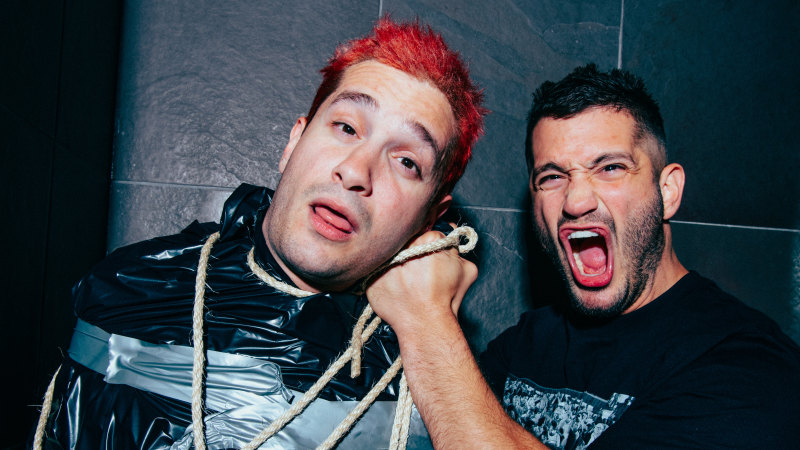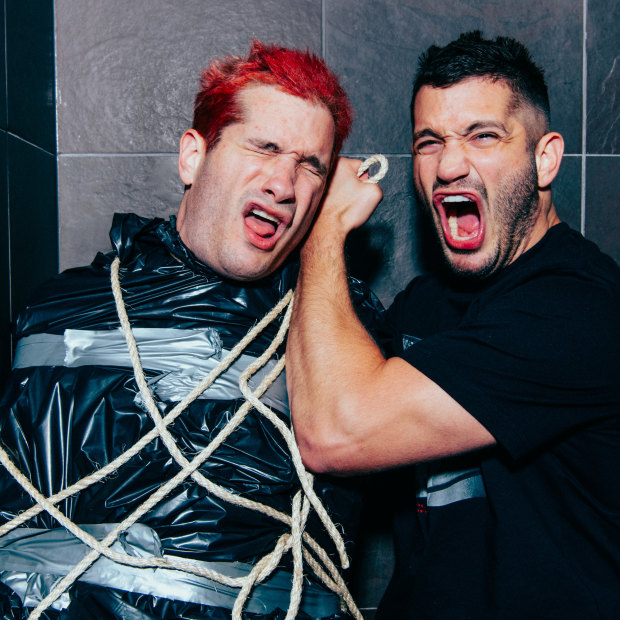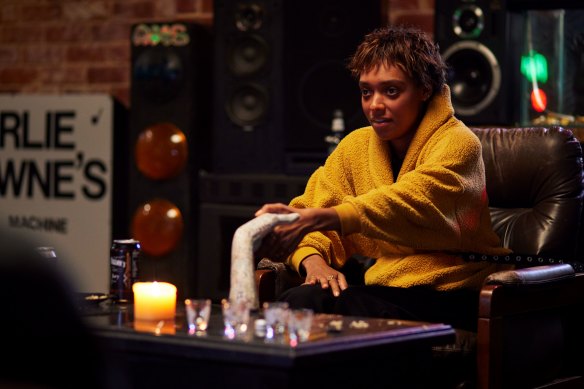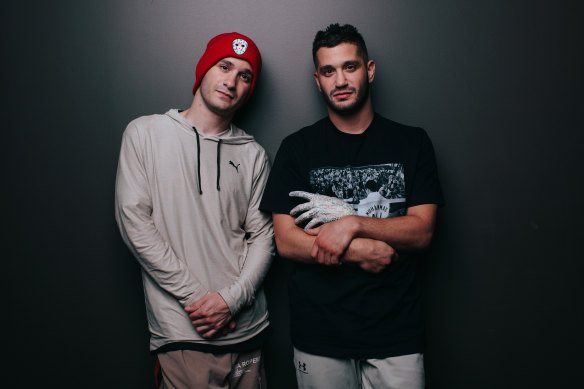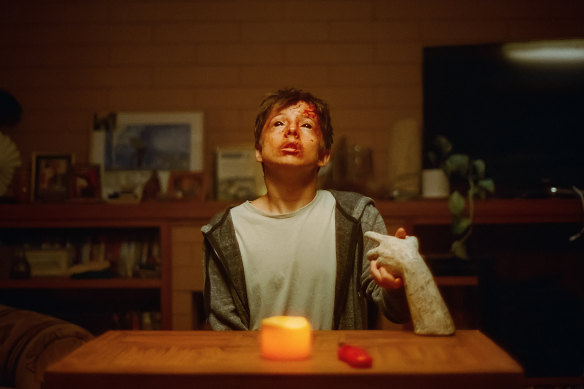By Karl Quinn
Twins and co-directors Danny (left) and Michael Philippou became internet stars with violent slapstick videos, and now they’re set for mainstream success at the cinema. Credit: James Brickwood
Save articles for later
Add articles to your saved list and come back to them any time.
There were times during the making of Talk To Me when twins Danny and Michael Philippou must have wondered if they had made the wrong call in turning down the backing of a Hollywood studio.
They kept creative control over their debut feature and resisted calls to lose the Australian setting, accents and cast, but it had come at the cost of a massively reduced budget – and it was starting to hurt.
“We were going to set one day and were filling up the car, and we couldn’t fill it up all the way because we didn’t have enough money, and we’re like, ‘Oh shit’,” says Danny, the younger of the Adelaide-raised brothers by six minutes.
“We got paid for the movie, apparently, but we had to reinvest our fees to make it. It was scary.”
Any doubts were dispelled, though, when their whip-smart horror film was swept up in a bidding war at the Sundance Film Festival in January, at the end of which the buzziest distributor on the planet, A24, had reportedly paid a “high seven-figure” sum for the North American rights.
Mia (Sophie Wilde) gets to grips with the hand in Talk To Me.Credit: Umbrella Entertainment
That effectively pushed the movie into profit before a single ticket had been sold anywhere.
For their producers, Causeway Films (the indie outfit behind The Babadook and The Nightingale), it was vindication of a strategy to go it alone. For Screen Australia, which had been funding the brothers’ short-form work for years, it was proof of the value of backing raw talent with potential. But for the brothers, it was simply the realisation of a dream they’d had since they first picked up their dad’s video camera and started recording their backyard stunts when they were nine years old.
“We’ve never been financially minded or business-minded,” Michael says. “It was [always a case of] whatever money we make goes straight back into the videos.”
“I remember one where we spent $100,000 on the video and made 36 bucks back or something,” Danny says.
Adds Michael: “It was 130 grand, and we made $87 revenue.”
Danny: “But it was a good video.”
Michael: “It was a good video. Money comes and goes, but that stuff is around forever.”
The Philippou brothers are 30, but in some ways it feels like they have been around forever, too. As RackaRacka (among other names), they have been on YouTube since 2013, posting videos that are dumb, funny, violent and insanely popular. Collectively they have clocked up more than a billion views on YouTube, where they have more than 6.7 million subscribers. They have a big presence on Facebook and TikTok, too.
They are credited as co-directors, but how does that work in practice?
“It’s whoever yells the loudest, or whose fist hits the hardest,” Danny says. “I feel I’m the main voice on set and Michael will look at the smaller details.”
Usually, if Michael wants to give a direction on set, he pulls Danny aside, whispers in his ear, and Danny relays it to the cast or crew. Occasionally, though, he bypasses his brother. “And I’d pull him to one side, write on my phone a little note and show it to him,” Danny says. “It says, ‘Stop f—ing contradicting me.’ ”
On set, Danny (left) is the dominant voice, while Michael tends to pay more attention to smaller details.Credit: James Brickwood
If there’s a single word that best describes the style of their YouTube work – which has led to them directing commercials in Norway in a similar vein – it would be mayhem.
In many of them, Michael is the principal stunt performer, and more than once he has been hurt in the name of entertainment. “There definitely was a time when it was like a wild west, it was out of control,” he says.
But none of it was ever done with the deliberate aim of harming anyone, insists Danny: “It was always ‘creative expression.’ ”
“People would say, ‘Oh, you guys are like Jackass’,” Michael says, “but in our minds we weren’t because we were always trying to tell a narrative. It was probably a really bad one, but it was in the context of a film, we were trying to tell a little story there, not just, ‘Let’s do this to hurt ourselves’ for no reason.”
The aim, always, was to become legit filmmakers. Both have been working on sets since they were 18, Michael as a runner, Danny in the electrical department. Even so, Danny says, stepping up to the scale of co-directing a feature “was very nerve-wracking and scary”.
Riley (Joe Bird) is dragged to the dark side.Credit: Umbrella Entertainment
Talk To Me revolves around the classic horror trope of an object serving as a portal to another dimension. The object in question is a sculpture of a hand, and by clutching it and uttering the words “talk to me” a subject can commune with the souls of the dead. Think of it as a more tactile version of a ouija board.
The hand comes into the possession of a group of teens who organise seance parties in which everyone takes turns to go into a trance for no more than 90 seconds, each of them emerging from it as if they’d just had a hit on some short-lasting euphoria-inducing drug. Naturally, things go horribly wrong when Mia (Sophie Wilde) – a young woman still trying to come to terms with the death of her mother – overstays her time, and a demon takes more than a passing interest in her soul.
It has all the scares and shocks you would expect from the genre, but like so much contemporary horror, Talk To Me has ambitions well beyond that, too.
“When I was writing, I was tapping into things that scared me, like mental illness and depression,” Danny says. “There was a suicide in our family, so I was always scared of that. ‘Does that mean we’re gonna get it because our mum has it and her grandmother had it?’ I was just expressing those fears in the film. So I don’t know where it sits in the whole genre, but it’s a really personal script and personal film.”
The hand, he continues, is a symbolic representation of all the things that start as an escape for kids but end up holding them in a vice-like grip. “Whether it’s drugs, alcohol, sex or whatever, we wanted the hand to represent all vices,” he says. “If you’re using it to escape something, you aren’t necessarily going to have a good time … it’s representing connection between people. I just like that it can be an allegory for many, many things.”
Says Michael: “It’s like when as a kid, you see someone drunk or whatever for the first time, it feels like a different person. That’s not the person you know, that’s a completely different person. Through the eyes of the kids, it’s good, and it’s fun and stuff, but there’s something else happening underneath that they’re not really aware of.”
The idea for the film came in part, the brothers say, from a video they saw in which a kid who lived down the road from their childhood home had a terrible episode while on drugs. “He was on the floor and convulsing, having a really negative reaction, and all the kids he was with weren’t helping him, they were filming him and laughing at him,” Danny says. “That was such striking, horrifying footage.”
They re-create that moment in the film, and it is indeed horrifying, pointing as it does to an erosion of empathy in a generation that increasingly experiences the world through the lens of a phone camera.
“It’s this generation’s thirst for attention, anything to get seen and get eyeballs on you,” Michael says. “You see people doing more and more ridiculous things to get that attention.”
But you guys were part of that, though, surely?
“We certainly were,” Michael says. “You’ve seen our videos.”
Do you think it’s taken a troubling turn more recently?
“No, I think social media today, while there’s a dark side, there’s a really good side as well,” Danny says. “People are able to express themselves, people that normally wouldn’t have a voice. I think that while there’s an ugly side to internet culture, there’s a really beautiful side to it as well. I’m not sitting here going, ‘Internet’s bad, video culture bad.’ I think it’s an awesome thing that everyone can express themselves.”
Adds Michael: “There’s positive and negative with it. Everyone’s more connected than ever now. You can speak to and find your tribe through the internet, you can be seen and noticed, and talent that would usually be buried gets seen now.”
Danny: “But at the same time, the negative side is that depression rates of teenagers are up as well because of social media. It’s constantly shifting and changing and there’s positives and negatives everywhere.”
And what of your relationship with that space? Now you’re up and running as fully fledged filmmakers, do you see yourselves maintaining a presence on YouTube et al or leaving it all behind?
“We love our audience and always want to be uploading in some way or other,” Michael says. “It’s just how much time you dedicate to that because we have so many ideas for feature films, but also we want to give back to the audience that helped us get here.”
Adds Danny: “We’re very ADHD, we’re working on so many things at once.”
Michael: “It’s pretty much people asking for more material, people wanting meetings.”
Danny fires back: “You’re the one who signed us up for a comic book, a video game and a documentary. It’s like, ‘OK, calm the f— down.’ ”
Danny has already finished the script for his next project, a horror film called Bring Her Back, which he hopes to shoot in Australia. The brothers are attached to a film version of the computer game Street Fighter, and there’s already talk of a Talk To Me Too.
In short, the answer to “what’s next” could be any of a number of things.
“We’re just doing so many things, I don’t know,” Danny says. “We’re going with the flow.”
Talk to Me is released in cinemas on July 27.
Contact the author at [email protected], follow him on Facebook at karlquinnjournalist and on Twitter @karlkwin, and read more of his work here.
Find out the next TV, streaming series and movies to add to your must-sees. Get The Watchlist delivered every Thursday.
Most Viewed in Culture
Source: Read Full Article
